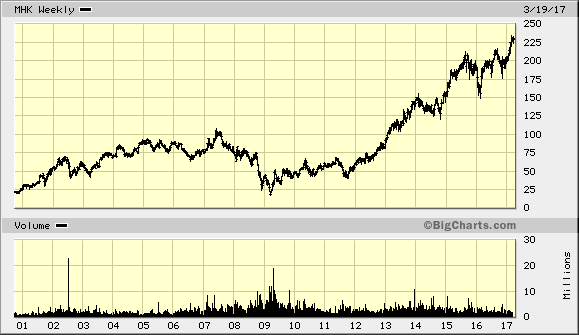It is 2006, and you want to know the true sustainable free cash flow of Mohawk because you love sleepy, mundane industries that are slowly growing. Why? Because people love to buy lottery tickets and glamour so you “go where they ain’t.”
So what is the difference between Mohawk’s GAAP earnings per share and your estimate of FREE CASH FLOW per share? Use cash flow from operations and maintenance capex (which you need to roughly estimate). Be roughly right, not precisely wrong.
Can you explain the difference? What is going on with Mohawk and the industry? Note the ten-bagger or 25% CAGR for almost ten years (move over Buffett) from the 2009 lows. Surprising or not? MHK-2006 AR FCF Analysis. Can you use this as a way to find other ten-baggers?
Of course, the above question is not hard for you since you have already read this 412 page book several times: Wiley Creative Cash Flow Reporting. You do not have needed to read that book to answer the question. Use common sense and a small bit of accounting knowledge like (amortization of goodwill-hint!)
This an example of how the analyst course would teach. You have to do many case studies to practice learning concepts like free cash flow. Like flying and sex, you have to practice.
—
Update: April 11, 2017: The price you pay
If you pay too much even for a great business, then you will have poor returns.
Take the three Value-Lines of Coke (KO). VL KO and note the $80 + plus price, then track its free cash flow (as calculated by Value-Line which is After-tax earnings plus depreciation + amortization then minus capital expenditures), then earnings. Track the price and those metrics: KO_VL_Jan 2013 and Ko_VL 2017. You will see that on average cash flows and earnings and dividends rise from 1998 until 2017, yet returns have been just OK. Paying too high a price hurts your total returns even with a strong, stable business like Coke. Investors were extremely optimistic over Coke’s growth prospects. If you held Coke for a long time, your return would equal the company’s long-term return on equity.
Also, Buffett’s non-controlled public investments have generally lagged the S&P 500 Berkshire Hathaway AR 2016.
—
Good luck. Those who do not provide the correct answer will have to spend time with my ex-wife:


18 responses to “An Example of the Analyst Course”